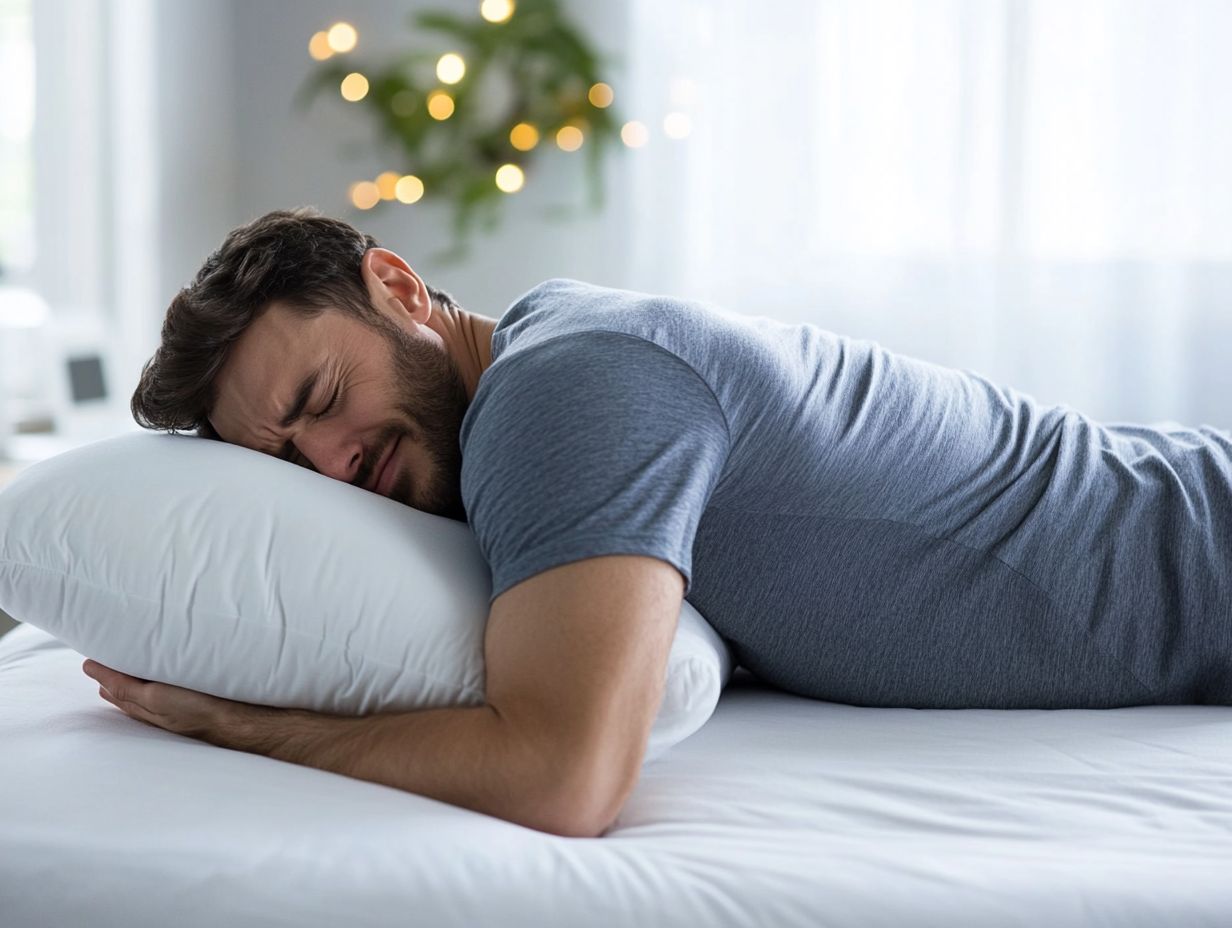The Best Sleeping Positions for Spine Health
Maintaining good spinal health is crucial for overall well-being, and surprisingly, the way you sleep plays a significant role.
Poor sleeping positions can lead to various spine issues, including discomfort and musculoskeletal disorders.
This article explores the best and worst sleeping positions for spine health, along with practical tips for enhancing sleep quality.
Simple adjustments can make a world of difference in how you feel when you wake up each day.
Understanding the Importance of Sleeping Positions

Sleeping positions are crucial in maintaining spinal alignment, which has a direct impact on sleep quality and overall health. The manner in which individuals position their bodies while sleeping can either support or impede the natural curvature of the spine, thereby affecting how they feel upon awakening. An optimal sleep position is essential for ensuring comfort during sleep, as it helps prevent common issues such as neck pain and back pain. Adopting healthy sleeping habits can significantly enhance overall well-being and facilitate restful sleep.
For example, sleeping on the back is often recommended, as it evenly distributes body weight and minimizes pressure points. Conversely, side sleeping may reduce occurrences of snoring and alleviate symptoms of acid reflux. On the other hand, improper alignment due to poor sleeping postures, such as sleeping on the stomach, can lead to considerable discomfort and long-term health complications.
To improve sleep quality, individuals should consider investing in supportive mattresses and pillows that promote proper alignment, as well as establishing nighttime routines that encourage relaxation. These practices will ultimately give the power to individuals to thrive during their waking hours.
Common Spine Issues Related to Sleep
Numerous individuals face spine-related issues that can often be attributed to improper sleeping positions. These issues frequently result in neck pain, back pain, and other complications such as herniated discs and muscle strain.
Misalignment of the spine during sleep can exert excessive pressure on the spinal discs, as well as the surrounding muscles and ligaments, leading to discomfort and potential long-term health problems. Recognizing and comprehending these common spine issues is crucial for enhancing sleep quality and promoting overall health.
Poor Posture Effects
Poor posture during sleep can have significant adverse effects on spinal alignment, often resulting in neck pain, back pain, and muscle strain. When the body is not positioned correctly on a firm surface, it can disrupt the natural curves of the spine, affecting both comfort and overall health.
This misalignment can create tension in the muscles and ligaments, further exacerbating discomfort and negatively influencing the quality of restorative sleep.
Inadequate support throughout the night may also impede recovery from daily activities and heighten the risk of chronic pain conditions. Over time, improper sleeping positions can contribute to issues such as herniated discs or sciatica, making it essential for individuals to prioritize their sleeping posture.
By cultivating good habits during rest, such as utilizing an appropriate pillow and mattress, individuals can significantly enhance spinal support and overall well-being. Acknowledging the importance of sleep alignment as a component of a healthy lifestyle can lead to improved rest, reduced pain levels, and better overall health outcomes.
Muscle Strain and Discomfort
Muscle strain and discomfort often result from improper sleeping positions, leading to persistent back and neck pain. When the spine is misaligned during sleep, it exerts excessive stress on the surrounding muscles, causing discomfort that can adversely affect sleep quality. Identifying and addressing the root causes of muscle strain is essential for achieving restful sleep and maintaining overall spinal health.
Suboptimal sleeping habits, such as using an excessive number of pillows or sleeping on an inadequate mattress, can further exacerbate these issues. Ensuring optimal spine alignment is crucial, as it allows the muscles to relax adequately during rest.
To alleviate strain, individuals should consider utilizing a supportive pillow that maintains proper neck alignment or selecting a mattress that strikes a balance between firmness and comfort. Additionally, incorporating gentle stretching exercises before bedtime can enhance flexibility and relaxation, thereby reducing tension and improving sleep quality.
By prioritizing spinal health, one can cultivate a more restorative sleep environment, ultimately mitigating the effects of muscle strain and discomfort.
Herniated Discs

Herniated discs represent a prevalent spinal issue that can be aggravated by improper sleeping positions, resulting in chronic back pain and diminished mobility. When the spine is not appropriately aligned during sleep, pressure may accumulate on the spinal discs, potentially leading to bulging or rupture. Understanding the significance of spinal alignment in the prevention of herniated discs is essential for maintaining a healthy back and ensuring effective pressure relief during sleep.
Selecting an appropriate sleep position can have a substantial impact on spinal health and overall comfort. For example, sleeping on the stomach often places excessive strain on the neck and lower back, whereas lying on the back or side encourages better alignment, enabling the spine to rest in its natural curvature.
Enhancing the sleep environment with a supportive mattress and pillow that cater to individual needs can further improve comfort and reduce the risks associated with herniated discs. By prioritizing these adjustments, individuals can promote restorative sleep while minimizing the likelihood of developing debilitating spinal conditions.
Impact of Sedentary Lifestyle
A sedentary lifestyle can have a significant impact on spinal alignment, frequently resulting in chronic back and neck pain. Extended periods of inactivity can lead to the weakening of the muscles that support the spine, thus emphasizing the importance of adopting healthy sleeping positions that promote proper alignment. By incorporating movement into daily routines, individuals can enhance their overall well-being and improve the quality of their sleep.
The connection between inadequate sleep positions and spinal health is critical, as improper postures during sleep can worsen discomfort and impede recovery. Implementing simple strategies, such as taking regular breaks to stretch, integrating light exercises throughout the day, or even choosing walking meetings, can lead to substantial improvements.
Engaging in these activities not only helps to maintain a robust and supportive muscle structure but also promotes better sleep hygiene. When the body remains active and the spine is adequately supported, individuals are more likely to experience deeper, more restorative sleep, which is vital for overall health and vitality.
The Best Sleeping Positions for Spine Health
Selecting optimal sleeping positions for spinal health is critical for achieving proper spinal alignment and alleviating common discomforts, such as neck and back pain.
Individuals who sleep on their backs, for example, benefit from maintaining a neutral position that ensures the spine remains aligned while providing adequate lumbar support. Conversely, side sleeping can also be advantageous when practiced correctly, as it can promote comfort and enhance overall sleep quality, especially when combined with a medium-firm mattress.
A thorough understanding of these positions can lead to healthier sleep habits and improved spinal health.
Sleeping on Your Back
Sleeping on one’s back is frequently regarded as the optimal position for maintaining spinal alignment and promoting a neutral posture that contributes to overall health. This position facilitates even weight distribution across the spine, thereby minimizing the likelihood of excessive pressure on any specific area, which may result in discomfort. Utilizing a supportive pillow to ensure proper lumbar support can enhance sleep comfort and prevent neck pain.
By adopting this position, the natural curvature of the spine is preserved, reducing the risk of developing chronic back pain and fostering healthier sleep patterns. It is advisable to select a pillow that is neither excessively lofty nor overly flat, ideally one that adequately supports the head without causing it to tilt forward or backward.
For individuals requiring additional support, placing a small pillow or rolled towel under the knees can further alleviate pressure on the lower back, enhancing overall comfort. Implementing these adjustments can lead to significantly more restorative nights, fully revitalizing the body for the day ahead.
Sleeping on Your Side

Sleeping on one’s side is a widely practiced position that can effectively support spinal alignment and enhance sleep quality when executed properly. This method can mitigate the risk of developing back and neck pain by promoting a more aligned posture, particularly when sufficient lower back support is prioritized.
When assuming the fetal position, it is essential to avoid excessive curling to maintain optimal alignment and comfort during sleep. Maintaining the hips stacked and the knees slightly bent can further enhance comfort and prevent strain on the spine.
Additionally, it is imperative to invest in a mattress that offers adequate support and cushioning to prevent sagging, which could compromise posture.
A pillow that supports the alignment of the head and neck is equally important; selecting a firmer pillow can ensure that the head remains aligned with the spine, thereby preventing stiffness upon waking.
By attending to these considerations, side sleepers can achieve a restful night while minimizing discomfort that may arise from improper sleeping positions.
Keeping Hips Stacked
Maintaining proper hip alignment while side sleeping is essential for preserving spinal alignment and preventing unnecessary strain on the back.
To achieve this alignment, it is recommended to place a supportive pillow between the knees. This practice not only aids in maintaining hip alignment but also alleviates tension in the lower back. Proper alignment supports the natural curvature of the spine, thereby reducing the risk of developing chronic pain or discomfort over time.
Individuals who adopt this technique frequently report improved overall comfort, which contributes to deeper and more restorative sleep. Consequently, this adjustment can lead to significant enhancements in daily functioning and overall well-being, making it a straightforward yet effective modification for those aiming to improve their sleep hygiene and daily productivity.
Avoiding Excessive Fetal Curl
Avoiding excessive fetal curl during side sleeping is crucial for maintaining proper spinal alignment and preventing lower back discomfort. When an individual curls too tightly in the fetal position, it can lead to misalignment of the spine, potentially exacerbating existing back pain and disrupting restful sleep. A more balanced posture promotes effective support for the lower back and ultimately enhances sleep quality.
To achieve an optimal side sleeping position, it is essential to ensure that the spine remains in a neutral alignment. Utilizing a supportive pillow that maintains the head in alignment with the spine can significantly enhance comfort.
Additionally, placing a cushion between the knees serves as an effective measure to mitigate hip and lower back strain. It is also important to consider the firmness of the mattress; a mattress that is too soft may result in sagging, while a firmer surface helps to maintain proper posture.
By implementing these adjustments, individuals can experience the benefits of side sleeping without compromising spinal health, leading to a more refreshing and restorative night’s sleep.
Sleeping in a Reclined Position
Sleeping in a reclined position can offer considerable advantages for spine alignment, particularly for individuals experiencing back or neck pain. This position facilitates even weight distribution along the spine, thus minimizing strain on the muscles and ligaments. Adopting a reclined angle can enhance sleep comfort, leading to more restful and restorative sleep cycles.
By maintaining an elevated upper body, this sleeping posture alleviates pressure on the lower back, which is especially beneficial for individuals with existing spinal concerns.
Utilizing adjustable beds provides the opportunity for personalized positioning, allowing individuals to identify their most comfortable angle. Additionally, pillows designed specifically for a reclined posture can augment this setup by providing further neck support and helping with the maintenance of proper alignment.
It is crucial to consider these options when establishing a sleeping arrangement aimed at fostering better spinal health, as minor adjustments can result in significant improvements in comfort and overall sleep quality.
The Worst Sleeping Position for Spine Health
Sleeping in a prone position is widely considered one of the least favorable sleeping postures for spinal health, as it can significantly impair spinal alignment. This position frequently necessitates twisting of the neck, which may result in neck pain and discomfort in the back.
Additionally, this unnatural posture can create pressure points that disrupt sleep and hinder recovery. Therefore, it is essential to explore healthier alternatives that promote improved spinal health.
Sleeping on Your Stomach
Sleeping in a prone position can lead to significant concerns regarding spinal alignment, often resulting in neck and back pain due to the unnatural posture it creates. This position exerts additional pressure on the spine and can disrupt its natural curvature, leading to discomfort and diminished sleep quality. Understanding the risks associated with stomach sleeping is crucial for improving overall health and achieving better pressure relief during rest.
This sleeping posture necessitates that the head is turned to one side, which can strain the neck and contribute to spinal misalignment over time. Consequently, individuals may experience chronic pain, stiffness, and increased tension in both the neck and back.
To alleviate these issues, it is advisable to consider alternative sleeping positions, such as supine (lying on the back) or lateral (lying on the side) positions. These alternatives promote better spinal alignment, thereby reducing unnecessary strain. Maintaining proper alignment can significantly enhance sleep quality, facilitating deeper rest and a more restorative slumber.
Tips for Enhancing Sleep Quality

Enhancing sleep quality is essential for promoting overall health and well-being, and several key strategies can significantly impact this outcome.
Selecting the appropriate mattress and pillow support is critical for maintaining proper spinal alignment and alleviating discomfort. Investing in a medium-firm mattress that provides adequate lumbar support can ensure optimal positioning for the spinal discs, resulting in improved sleep quality and a healthier lifestyle.
Selecting an Appropriate Mattress
Selecting an appropriate mattress is a critical factor in achieving optimal spinal alignment and ensuring quality sleep. A medium-firm mattress is frequently recommended, as it offers an ideal balance of support and pressure relief, allowing the spine to maintain its natural curvature during rest. This selection can significantly reduce the risk of developing back pain and enhance overall sleep quality.
When evaluating different mattress types, it is essential to consider how each influences body support. For example, memory foam conforms to individual body shapes, effectively distributing weight and minimizing pressure points, which is vital for achieving restful sleep.
In contrast, innerspring mattresses typically provide a bouncier feel, with varying levels of firmness that accommodate different sleeping positions. Individuals who sleep on their sides may prefer softer materials to support their shoulders and hips, while back or stomach sleepers may benefit from a firmer surface to maintain proper alignment.
Ultimately, understanding these nuances will assist individuals in making an informed decision that promotes both comfort and health.
Choosing the Right Pillow
Selecting the appropriate pillow support is critical for maintaining proper spinal alignment and preventing neck and back pain during sleep. An ideal pillow should complement the individual’s sleeping position, providing adequate support to ensure that the neck and spine remain aligned. Choosing a pillow with appropriate height can enhance overall sleep quality and contribute to a more restorative night’s rest.
Understanding the nuances of individual sleeping habits is instrumental in making an informed choice. For example, side sleepers typically benefit from a firmer, higher pillow that fills the gap between the shoulder and head, thereby ensuring proper spinal alignment.
In contrast, back sleepers may find that a medium-loft pillow is more advantageous, offering necessary support without excessively elevating the head. Stomach sleepers, however, often require a softer, flatter pillow to alleviate strain on the neck.
By recognizing these differences and taking personal preferences into account, individuals can significantly reduce the risk of discomfort and enhance overall well-being during sleep.
Maintaining Proper Alignment
Maintaining proper alignment during sleep is essential for overall spinal health and comfort. Ensuring that the body is positioned correctly, whether lying on the back or side, can prevent strain on the muscles and ligaments, thereby reducing the risk of neck and back pain. Adopting healthy sleeping practices contributes to an improved lifestyle and enhances sleep quality.
To achieve optimal alignment, it is crucial to invest in a quality mattress that supports the natural curves of the spine. Additionally, utilizing pillows to provide support for the head and neck can significantly aid in maintaining proper alignment. For individuals who sleep on their side, placing a pillow between the knees can help keep the hips properly aligned, while back sleepers may benefit from additional support under the knees.
Furthermore, minimizing distractions such as excessive light and noise in the sleeping environment can promote restful sleep, ultimately facilitating rejuvenation and enhancing overall well-being.
Final Thoughts on Spine Health and Sleep
Prioritizing spine health and sleep quality is crucial for achieving a healthier lifestyle and alleviating issues such as back pain and neck pain.
When individuals take the time to evaluate their sleeping environment and carefully consider the appropriate combinations of mattress firmness and pillow height, they create conditions conducive to restful nights, which significantly contribute to overall wellness.
Implementing straightforward adjustments, such as practicing good sleep hygiene, maintaining a consistent sleep schedule, and engaging in calming bedtime routines, can have a profound impact on how effectively the body recuperates overnight.
By adopting these strategies, individuals can enhance the quality of their sleep while simultaneously supporting spinal alignment, ultimately leading to a more energized and pain-free day.
